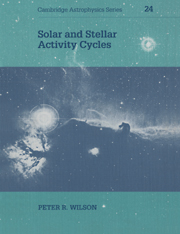Book contents
- Frontmatter
- Contents
- Preface
- Acknowledgments
- 1 Introduction
- 2 Historical survey
- 3 The structure of the Sun and the phenomena of activity
- 4 The equations of magnetohydrodynamics and magnetohydrostatics
- 5 The one-dimensional configuration of the cycle
- 6 Heuristic models of the solar activity cycle
- 7 Stellar activity and activity cycles
- 8 The two-dimensional representation of the extended activity cycle
- 9 The origin of the large-scale fields
- 10 The reversal of the polar magnetic fields
- 11 The role of dynamo theory in cyclic activity
- 12 Helioseismology and the solar cycle
- 13 Cyclic activity and chaos
- 14 Forecasting the solar cycle
- 15 Summary and conclusions
- Author index
- Subject index
1 - Introduction
Published online by Cambridge University Press: 27 October 2009
- Frontmatter
- Contents
- Preface
- Acknowledgments
- 1 Introduction
- 2 Historical survey
- 3 The structure of the Sun and the phenomena of activity
- 4 The equations of magnetohydrodynamics and magnetohydrostatics
- 5 The one-dimensional configuration of the cycle
- 6 Heuristic models of the solar activity cycle
- 7 Stellar activity and activity cycles
- 8 The two-dimensional representation of the extended activity cycle
- 9 The origin of the large-scale fields
- 10 The reversal of the polar magnetic fields
- 11 The role of dynamo theory in cyclic activity
- 12 Helioseismology and the solar cycle
- 13 Cyclic activity and chaos
- 14 Forecasting the solar cycle
- 15 Summary and conclusions
- Author index
- Subject index
Summary
‘Where shall I begin, please your Majesty?’ the White Rabbit asked.
‘Begin at the beginning,’ the King said, very gravely…
Lewis CarrolThe significance of stellar activity cycles
During the twentieth century, our perception of the fundamental nature of stars and stellar systems has undergone a revolution almost as profound as that initiated by Copernicus in relation to the solar system. In the nineteenth century, a star was regarded as a luminous, spherically symmetric system, for which the only available energy source appeared to be the energy released by gravitational contraction. Unfortunately, simple calculations showed that, on this basis, the Sun's luminous lifetime (the Kelvin-Helmholtz time) was far too short to accommodate the age of geological structures, the development of life, and the evolution of species.
The discovery that nuclear energy could provide the source necessary to prolong the luminous lifetimes of stars by several orders of magnitude was the first significant development in our understanding and provided the background structure for the picture of a star that emerged in the first half of this century: i.e. that of an equilibrium system, in which the internal generation of nuclear energy remained in long-term balance with the radiation emitted at the surface. In this system, it was assumed that hydrostatic pressure balance applied and that the outward temperature gradient was monotonically negative, in conformity with the well-understood principles of thermodynamics.
- Type
- Chapter
- Information
- Solar and Stellar Activity Cycles , pp. 1 - 8Publisher: Cambridge University PressPrint publication year: 1994



